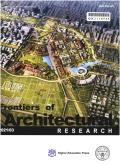Study on the gene mapping and formation mechanism of historical buildings influenced by multiculturalism: A case of Gulangyu, China
IF 3.6
1区 艺术学
0 ARCHITECTURE
引用次数: 0
Abstract
Historical buildings influenced by multiculturalism exhibit characteristics of stylistic integration and cultural complexity. Research on multicultural architecture is significant for understanding the collision and fusion of diverse cultures. Currently, studies in this field primarily focus on the qualitative descriptions of architectural styles. In this study, we analyze the floor plans of historical buildings located in the World Cultural Heritage site of Gulangyu Island. Utilizing methods such as typology, spatial schema, space syntax, cluster analysis, and regression analysis, we investigate their gene mapping and formation mechanisms. The results indicate the following: The gene mapping of multicultural plan variants (denoted as "V"), can be expressed as follows: V = L × + F × , where "L" represents the local planar prototype, and "F" denotes the foreign planar prototype, and ). These variants can be classified into three types. Multicultural plan variants include three generative mechanisms: "Imitation," "Compromise," and "Variation." The spatial layout, central positioning, and traffic flow lines reflect the "Imitation" of local planar prototypes. Connectivity and integration illustrate the "Compromise" between local and foreign planar prototypes. Topological structures and topological depth represent the "Variation" influenced by foreign planar prototypes.
多元文化影响下历史建筑基因定位与形成机制研究——以鼓浪屿为例
受多元文化影响的历史建筑表现出风格统一性和文化复杂性的特点。研究多元文化建筑对于理解不同文化的碰撞与融合具有重要意义。目前,该领域的研究主要集中在对建筑风格的定性描述上。在本研究中,我们对鼓浪屿世界文化遗产地的历史建筑平面图进行了分析。利用类型学、空间图式、空间句法、聚类分析和回归分析等方法,研究了它们的基因定位和形成机制。结果表明:多文化平面变异的基因定位(用“V”表示)可以表示为:V = L × X% + F × Y%,其中“L”表示本地平面原型,“F”表示外来平面原型,X+Y=100)。这些变体可以分为三种类型。多元文化规划变体包括三种生成机制:“模仿”、“妥协”和“变异”。空间布局、中心定位、交通流线都体现了对当地平面原型的“模仿”。连通性和集成说明了本地和外部平面原型之间的“妥协”。拓扑结构和拓扑深度代表了受外来平面原型影响的“变异”。
本文章由计算机程序翻译,如有差异,请以英文原文为准。
求助全文
约1分钟内获得全文
求助全文
来源期刊

Frontiers of Architectural Research
ARCHITECTURE-
CiteScore
6.20
自引率
2.90%
发文量
430
审稿时长
30 weeks
期刊介绍:
Frontiers of Architectural Research is an international journal that publishes original research papers, review articles, and case studies to promote rapid communication and exchange among scholars, architects, and engineers. This journal introduces and reviews significant and pioneering achievements in the field of architecture research. Subject areas include the primary branches of architecture, such as architectural design and theory, architectural science and technology, urban planning, landscaping architecture, existing building renovation, and architectural heritage conservation. The journal encourages studies based on a rigorous scientific approach and state-of-the-art technology. All published papers reflect original research works and basic theories, models, computing, and design in architecture. High-quality papers addressing the social aspects of architecture are also welcome. This journal is strictly peer-reviewed and accepts only original manuscripts submitted in English.
 求助内容:
求助内容: 应助结果提醒方式:
应助结果提醒方式:


